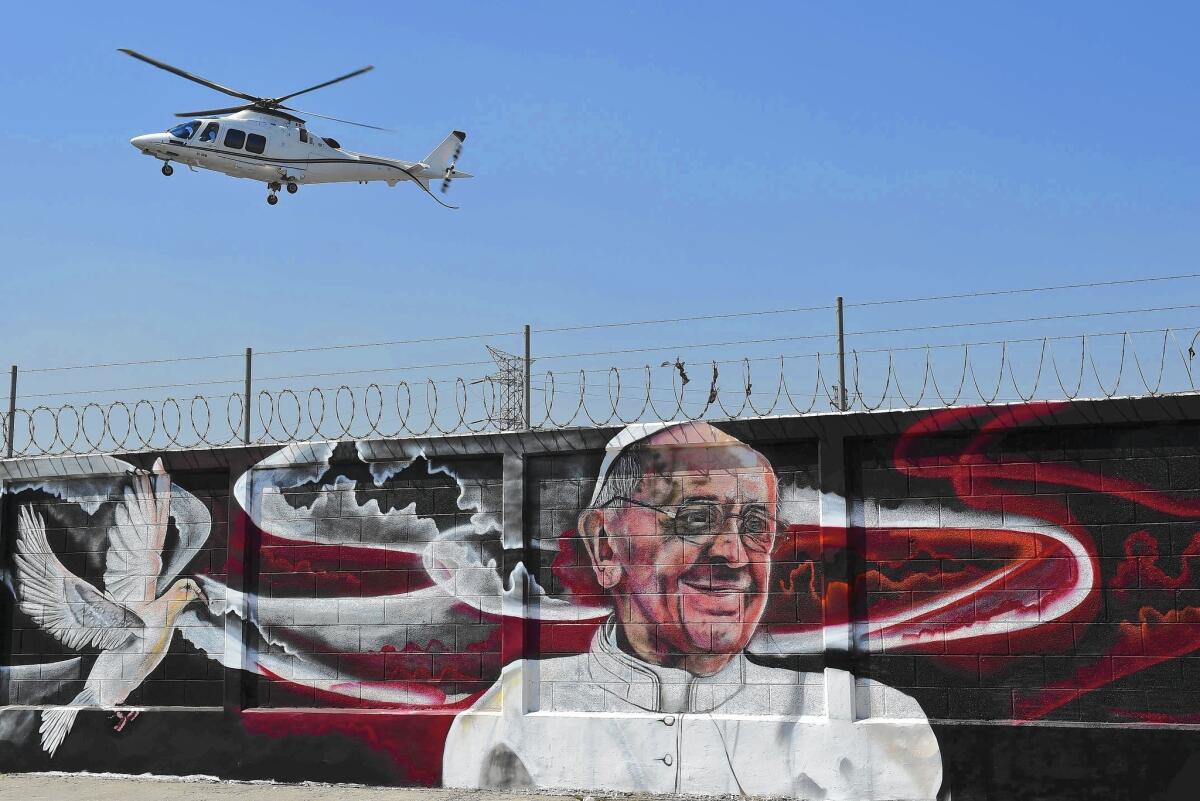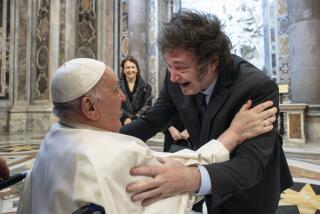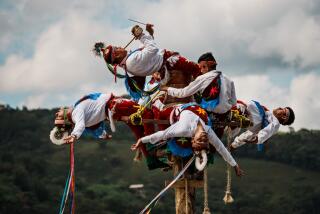Pope Francis plans a symbolically freighted trip to Mexico

A mural welcomes Pope Francis to Ecatepec, outside Mexico City. The pope arrives in Mexico on Friday.
Pope Francis travels to Mexico this week, saying he wants to “live the faith” of the overwhelmingly Catholic country but will not shy away from confronting issues of violence and corruption that could make his governmental hosts quite uncomfortable.
History’s first pontiff from the Americas will also stand on Mexico’s border with the United States and make an impassioned plea for the plight of immigrants. His entire pilgrimage from southern to northern Mexico is meant to represent the perilous route that migrants take to reach the U.S.
This is the Argentine pope’s fourth trip to Latin America, home to Roman Catholic communities that are the largest in the world but have faced challenges from the spread of Protestantism, loss of faith and slowed population growth because of migration, homicide and lower birth rates.
Si desea leer esta nota en español, haga clic aqui.
The Mexico that Francis visits, following the well-worn path of his two predecessors, is enduring a decade-old wave of brutal criminal and “narco” warfare, a spate of egregious human rights abuses, an economic slump and official corruption that has helped take President Enrique Peña Nieto’s approval rating to historic lows.
“You are living your little piece of war,” Francis said last week in a video message to Mexicans via the semiofficial Notimex news agency.
“The Mexico of violence, the Mexico of corruption, the Mexico of drug trafficking, the Mexico of cartels, is not the Mexico that our mother [the Virgin Mary] wants,” he added. “I, of course, will not cover any of that up.
“To the contrary,” he added, “I want to exhort you to fight every day against corruption, against trafficking, against war, disunity, organized crime.”
Even before the pope sets foot Friday on Mexican soil, government officials were incensed by his comments.
“Undoubtedly, he has certain information,” Interior Minister Miguel Angel Osorio Chong said. “The best information will be what he can see here.”
Mexico was once a highly anticlerical country; after the 1910 revolution, the government confiscated church property and prohibited priests from wearing their collars and robes in public.
That trend has been reversed; diplomatic ties with the Holy See were established in 1994, and many clerics today tend to be supportive of the government of the moment. Despite losses and a strong secular strain, Mexico remains more than 80% Catholic.
The six cities that Francis has chosen to place on his itinerary speak volumes of his intended message.
He will come to this sprawling megalopolis, site of the Basilica of the Virgin of Guadalupe, patron saint of Mexico and all the Americas; worship of her goes to the heart even of secular Mexicans here and in Southern California.
Just outside Mexico City lies the notoriously poor and dangerous city of Ecatepec, where nearly 2 million live. Part of the state of Mexico, governed by Peña Nieto before he became president, Ecatepec also has one of the country’s highest incidents of killings of women.
He will say Mass in Morelia, capital of Michoacan state, one of the top sources of migrants who live in the U.S. It is also a region that has been terrorized by a pseudo-religious drug gang, La Familia Michoacana, and its successor, the Knights Templar, and where rural priests have been killed, kidnapped and threatened.
Join the conversation on Facebook >>
Francis gave Morelia a cardinal just last year, Alberto Suarez Inda, and he is expected to console and praise Suarez and the priests of Michoacan for doing God’s work ministering to the faithful in the face of such dangers. The government has already dispatched the army and navy to back up police in Morelia for the pope’s visit.
Francis will tread into the least traditionally Catholic state, Chiapas, on Mexico’s border with Guatemala and home to many semiautonomous indigenous communities.
Protestant Pentecostalism has made significant inroads in Chiapas, and so has liberation theology, the pro-left version of Christianity that had fallen out of favor at the Vatican — until the ascension in 2013 of Francis, a vocal proponent of the doctrine’s emphasis on the poor.
Chiapas is Mexico’s most impoverished and neglected state. In the picturesque, mountainous city of San Cristobal de las Casas, Francis will lead prayers using indigenous languages, such as Tzotzil and Chol, and will feature Maya dance and symbols, Bishop Felipe Arizmendi Esquivel said.
The pontiff will issue rules to formally allow the use of indigenous languages in church services, something that Francis’ predecessor, Benedict XVI, had discouraged.
Francis also chose Chiapas because it is the most common entry point for Central American migrants fleeing nightmarish bloodshed and crushing poverty and hoping to reach the U.S.
His final stop is the northern border city of Juarez, across the Rio Grande from El Paso, thus symbolically tracing the route of migrants.
Juarez once had the highest murder rate of the country and, possibly, all of Latin America. But a combination of developments, including the apparent victory of one drug gang over its rivals, as well as social programs launched by private business, has significantly reduced the killing.
In what is expected to be one of the most emotional moments of the pope’s pilgrimage, he will preside over a cross-border Mass on Feb. 17, with perhaps 200,000 on the Juarez side and others on the U.S. side. About 50,000 will watch a simulcast at El Paso’s Sun Bowl stadium. The stage from which he will pray is only about 80 yards from the border fence, and he plans to ride along the barrier in his popemobile.
“The Mass will be deliberately visible from both sides,” Vatican spokesman Father Federico Lombardi said in a briefing for reporters in Rome.
The event follows a tradition started by U.S. bishops of saying Mass at the border fence in a show of unity and support for migrants.
Lombardi also said that victims of Mexico’s conflicts, including relatives of some of the more than 20,000 people missing in the country, have been invited to attend the Juarez ceremony. Among them, he confirmed, will be relatives of the 43 Mexican college students kidnapped by police working with local politicians 16 months ago. The students were killed, a case that continues to roil the nation.
The families had requested a private meeting with the pope, but Lombardi said it could not be fit into the itinerary. “It will not be an individual meeting, because of his timetable, but their request to participate has been met,” he said.
With nonstop television coverage of the pope in Mexico, the Peña Nieto administration and his Institutional Revolutionary Party, or PRI, may hope to score political points. Regional elections are taking place this year in 13 states, where the PRI will want to gain or expand its power.
Suspicion among many Mexicans that that is the government’s ulterior motive has led to a lot of anger about what will undoubtedly be an elaborate and expensive spectacle. A Twitter campaign has grown in recent days with the hashtag yonoquieroquevengaelpapa (“I don’t want the pope to come”).
But if favorable publicity informs the government’s calculation, it may not work, especially if Francis holds true to his tendencies to chide the powerful.
“The pope does not hesitate to speak frankly and directly to the communities he visits,” said Father Kevin F. O’Brien, vice president for mission and ministry at Georgetown University in Washington and, like the pope, a Jesuit.
He recalled the pope’s admonition of the Mafia during a visit to Sicily and denunciation of the treatment of immigrants at Lampedusa, the Italian island where many African and Middle Eastern refugees have washed ashore and often died.
On the eve of the pope’s arrival, the Catholic Church in Mexico issued a scathing editorial that in many ways sets the tone of the visit.
“Mexico is facing violence and criminal phenomena that appear unprecedented in its modern history,” the editorial, published in the Mexican Archdiocese’s Desde la Fe magazine, said. “It makes us question the capability of authorities at every level of government.”
Andrew Chesnut, professor of religious studies at Virginia Commonwealth University, said Francis’ trips to Mexico and to Brazil in 2013 are the most important of his “dynamic” papacy — and Mexico even more so because the Brazil event had been planned by Benedict before his surprise resignation.
“One of the main reasons a Latin American was elected pope was to try to reverse the sharp decline of the Catholic Church in the region over the past five decades,” Chesnut said. “In the context of the hemorrhaging of members … Mexico emerges as the most pivotal tour to date, also because several of the major themes of the trip echo his larger, global agenda, such as migrants, refugees, corruption and violence.”
In his Notimex remarks, the pope also cautioned against exaggerated expectations: “I am not going to Mexico as one of the Three Wise Men, loaded with [gifts], messages, ideas, solutions to problems.
“I am going to Mexico as a pilgrim, to seek the wealth of faith that you all have. I want to become infected with that wealth of faith, to live that faith with you. I am going with my heart open so that it might fill with all you can give me.”
Times staff writer Wilkinson reported from Washington and special correspondent Sanchez from Mexico City. Special correspondent Tom Kington contributed from Vatican City.
Hoy: Léa esta historia en español
ALSO
6th Street Bridge finally starts to fall to demolition crews
After San Bernardino terror attack, many are attending active shooter trainings
Local efforts to raise minimum wage could take a back seat as cities wait for state to act
More to Read
Start your day right
Sign up for Essential California for news, features and recommendations from the L.A. Times and beyond in your inbox six days a week.
You may occasionally receive promotional content from the Los Angeles Times.







